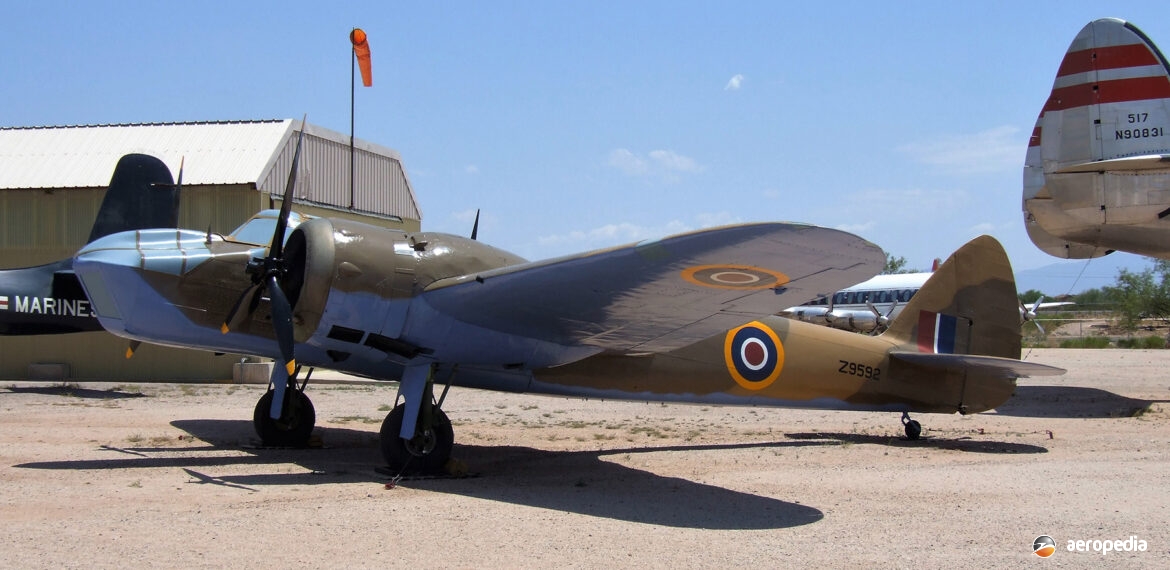Photograph:
Bristol Bolingbroke IV Z9592 at the Pima Air Museum in Arizona in 2007 (David C Eyre)
Country of origin:
United Kingdom
Description:
Three-seat light twin-engine bomber
Power Plant:
Two 675 kw (905 hp) Bristol Mercury XV nine-cylinder air-cooled radial engines
Specifications:
- Wingspan: 17.17 m (56 ft 4 in)
- Length: 13.03 m (42 ft 9 in)
- Height tail down: 3.89 m (12 ft 9 in)
- Wing area: 43.57 m² (469 sq ft)
- Max speed at 3,597 m (11,800 ft): 428 km/h (266 mph)
- Max cruising speed at 4,575 m (15,000 ft): 362 km/h (225 mph)
- Economical cruising speed at 4,575 m (15,000 ft): 274 km/h (170 mph)
- Service ceiling: 6,706 m (22,000 ft)
- Time to 4,575 m (15,000 ft): 17 mins
- Range at 363 km/h (225 mph): 1,866 km (1,160 miles)
- Range at 274 km/h (170 mph): 2,344 km (1,457 miles)
- Take-off distance to 15 m (50 ft): 850 m (2,820 ft)
- Empty weight: 4,445 kg (9,790 lb)
- Normal loaded weight: 6,538 kg (14,400 lb)
- Max overload weight: 7,120 kg (15,682 lb)
Armament:
One 7.7 mm (0.303 in) fixed Browning machine gun in port wing; one 7.7 mm (0.303 in) Vickers
machine gun in nose; two 7.7 mm (0.303 in) Browning machine guns in dorsal turret; one 7.7 mm
(0.303 in) fixed rearward firing Browning machine gun in fairing under nose; internal bomb bay for
454 kg (1,000 lb)
History:
The Bristol Blenheim was built in large numbers for the Royal Air Force and bore the brunt of operations in France at the beginning of World War II with the British Expeditionary Force until the French Government capitulated. It also played a significant role in the Western Desert campaign and was used extensively in Burma and Malaya. It initially showed outstanding performance as a light bomber at the time of its introduction but in 1940 and 1941 suffered a high loss rate. With the development of other aircraft types it soon became obsolescent.
The origins of the Blenheim commenced in 1933 when the chief designer of Bristol, Frank Barnwell, commenced design of a high-speed passenger aircraft with Bristol Aquila radial engines. Development continued to the Type 142M and the first production prototype (K7033) flew on 25 June 1936, the first 150 aircraft being delivered to the RAF within 12 months from January 1937. Licence production of the type took place in Finland, Yugoslavia and Canada. By the time production concluded, 6,200 examples had been produced. By the commencement of World War II in September 1939, 1,089 examples were in service with the RAF.
There were two main developments of the Type 142M Blenheim, the Mk 1 short-nose variant: the Type 149 known as the long-nose model and the Type 160 which became the Mk V in 1943. Built in Canada, the Mk V became known as the Bolingbroke. This model had extra fuel tanks in the outer wings and a lengthened nose to give more room for the crew. The engines were the up-rated Bristol Mercury XV which used 100 octane fuel.
The Mk V served with front line squadrons in the Middle and Far East, mainly in support and training roles. After the war the type remained in service with the RCAF. The Finnish Air Force operated the type right up to the time of the German surrender. Before the war it was known as an ultra modern high-performance bomber but, with advances in technology, soon after the conflict commenced it was found to be wanting. However, it became a “jack-of-all-trades” and, in addition to reconnaissance, anti-submarine and shipping roles, it also saw service in the night fighter role, one attacking and sinking a German submarine on 11 March 1940.
After retirement from front-line service, most survivors ended their days at operational training units.
A number of examples have survived in museums around the world. One (Mk IVT ex RCAF 10038) was restored as a Mk 1 in the United Kingdom by the British Aerial Museum as G Mk IV and made its post-restoration flight on 22 May 1987 but crashed at Denham in Buckinghamshire on 21 June that year. Another (Mk IVT ex RCAF 10201) was obtained from Canada and restored by the Aircraft Restoration Company at Duxford in Cambridgeshire as G-BPIV but suffered a landing accident on 18 August 2003 and has been rebuilt.
Three RAAF Squadrons operated the Bristol Blenheim IV in the European Theatre, these being Nos 454, 456 and 459. No 489 Squadron RNZAF also operated the Blenheim Mk IVF, being formed at RAF Leuchars on the east coast of Scotland with Bristol Beauforts but, as this type was in short supply, a number of Bristol Blenheims were attached to the unit before it moved on to the Handley Page Hampden. All of these units operated under the auspices of RAF Coastal Command and were, amongst other duties, used on anti-submarine patrol work.
In 2005 a plan was announced for a syndicate to obtain and restore to airworthy condition a Blenheim IV (Canadian-built Bolingbroke), the idea being advanced by the marketing manager of an aircraft maintenance and overhaul business, stating if the community was prepared to fund the acquisition and make a home for the project, the aircraft would be imported and parts and materials would be supplied. The Nelson Marlborough Institute of Technology was to manage some aspects of the project as an educational exercise, and a number of businesses stated they would assist with the project.
The plan was for the project to be obtained from the United States and the aircraft to be shipped to Blenheim in the south island by November 2005 for the opening of the Aviation Heritage Centre at Omaka. The airframe was made available “at a heavily discounted price” and was known as Blenheim Project-2961 but it seems the project did not proceed and the aircraft was not imported.

